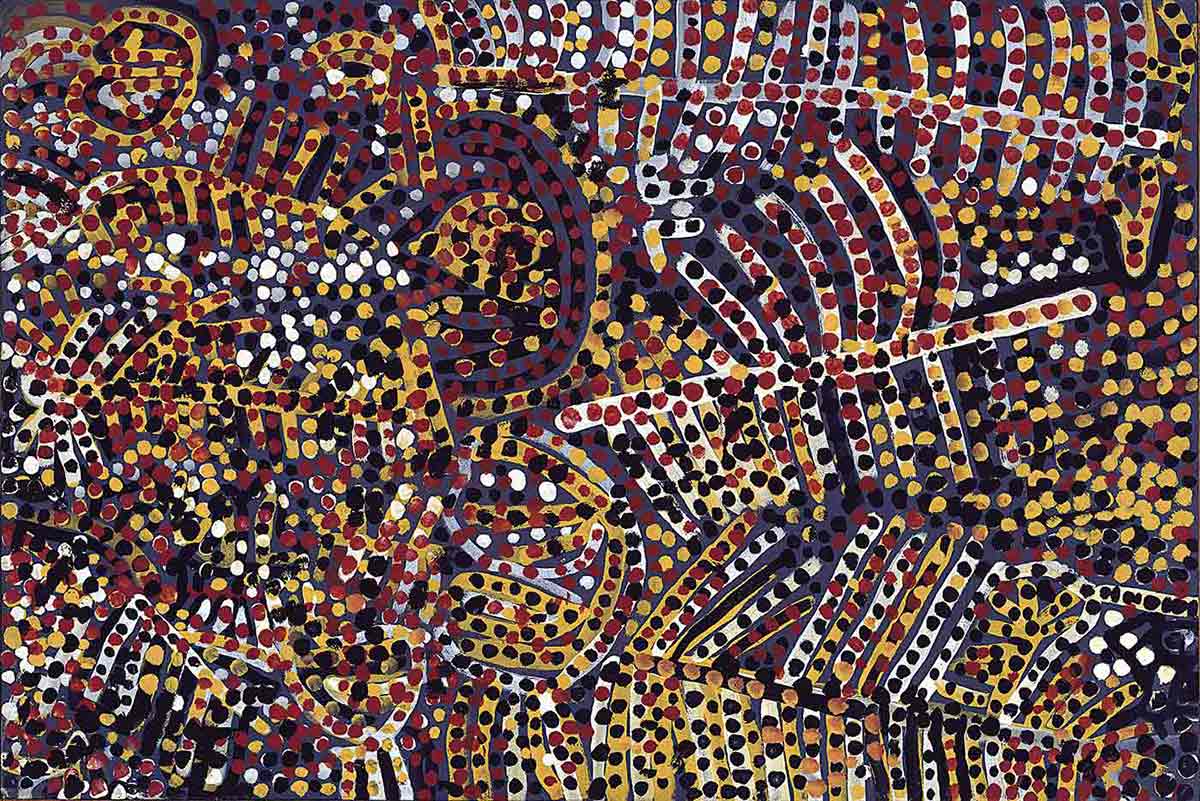about 1910
Emily Kame Kngwarreye is born in her Country, Alhalkere, about 230 kilometres north-east of Alice Springs in Central Australia. It is here that she first encounters a white man (and horses) when she is about 10 years of age.
1920s
The first pastoralists settle in the lands of the Anmatyerre and Alyawarr peoples, which include Emily's Country, and name the area Utopia.
1930s and 1940s
Emily undergoes an arranged marriage. Like many other Aboriginal people, Emily and her husband work on pastoral properties. She also works the camel teams carrying supplies between Alcoota and Wolfram Mine on Mount Riddock station. Late in the 1940s Emily remarries, in what she calls a 'love match'.
1976
Aboriginal land rights are granted in the Northern Territory and Emily moves off the pastoral property.
1977
Batik-making is introduced to women in Utopia as part of an extended government-funded education program. This is the beginning of Emily's use of introduced material in her art.
1978
Utopia Women's Batik Group is formed, with Emily as a founding member.
1979
Emily and other women involved in the Utopia land claim perform an Awelye ceremony before a bush hearing of the Land Claim Tribunal, demonstrating the powerful nature of art as evidence for showing connection to Country. The Anmatyerre and Alyawarr peoples gain freehold title to Utopia under the Aboriginal Land Rights (Northern Territory) Act 1976.
1988
The Central Australian Aboriginal Media Association (CAAMA) completes its first project with the Utopia Women's Batik Group, called Utopia – A Picture Story. The 88 silk batiks are acquired by the Holmes à Court Collection in Perth.
1988–89
The CAAMA shop, based in Alice Springs, initiates a project introducing the Utopia Women's Batik Group to painting on canvas with acrylic paints. Among the 81 works completed is Emily Kame Kngwarreye's first canvas, Emu Woman, which instantly attracts attention. Demand for her work escalates at a phenomenal rate until her death, nearly 8 years later. It is estimated that Emily produced more than 3,000 works in 8 years, an average of one per day.
1989
Emily Kame Kngwarreye and Louie Pwerle are the first recipients of the CAAMA/Utopia Artists-in-Residence Project funded by the Robert Holmes à Court Foundation. This residency was completed at Utopia.
1990
With Louie Pwerle, Emily makes a rare trip out of the desert to an exhibition of their paintings at the Perth Institute of Contemporary Art. Emily has five solo exhibitions in Sydney, Melbourne and Brisbane, in addition to 12 group exhibitions.
1992
Emily travels to Canberra to receive an Australian Artists Creative Fellowship from the prime minister, Paul Keating. It is the first time an Indigenous artist has received this prestigious award.
1993
Emily completes her 22-panelled work, Alhalkere Suite, for entry in the Joan and Peter Clemenger Contemporary Art Award at the National Gallery of Victoria. The work is now owned by the National Gallery of Australia.
1995
Emily's epic 8 x 3 metre work, Big Yam Dreaming, is completed and donated to the National Gallery of Victoria.
1996
A major national touring retrospective of Emily's work scheduled for 1998 is planned by the Queensland Art Gallery. Emily makes a tribute to the gallery by doing her final major installation, the 18-piece Utopia Panels. In the last 2 weeks before her death, Emily paints a series of 24 small canvases over a period of 3 days, referred to as 'The last series'. These works represent a radical departure from all previous work.
Emily dies on 2 September 1996.
